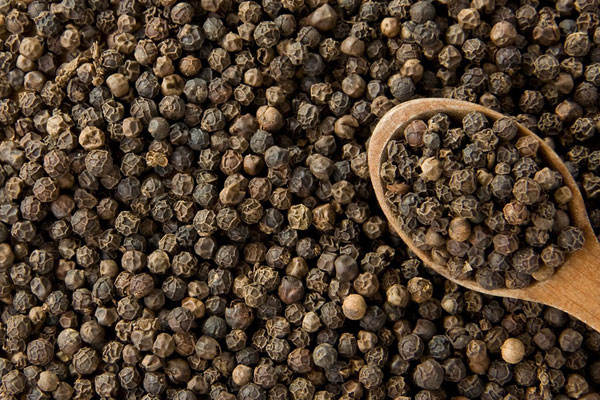Introduction
Taxonomy
- Family-Piperaceae
- Botanical name-Piper nigrum
- Common Name-Pepper
General Description
Pepper, popularly known as the "King of spices" and it accounts for occupies largest percentage in the international spice trade. It is most widely used spice all over the world. Black pepper of commerce is the mature dried berries of the woody perennial evergreen climbing vine, Piper nigrum. Pepper is cultivated over an area of 32,800 ha of Sri Lanka and Matale, Kandy, Kegalle, Kurunegala and Nuwara Eliya are accounted as major districts of cultivation.
It can be grown either as a mono crop or as a mixed crop in the coconut and tea plantations using live and dead standards as support. Pepper is an ideal crop for home gardens where it can be trained on the existing tree species as well.
Sri Lankan black pepper has higher piperine content which conduces to fetch a premium price in international spice trade.
Cultivation
Agronomic Requirements for cultivation
The plant can be grown up to the elevations of 1,200m from the sea level with an annual rainfall of not less than 1,750mm. Areas with prolonged drought may not be suitable unless there are adequate facilities for irrigation. Prevalence of sufficient rainfall during the flowering season is essential to ensure maximum pollination. Being a crop of the humid tropics, its growth and yield performances will be better in areas with low diurnal variation in temperature.

The plant can tolerate a wide range of temperature fluctuation from 10°C to 40°C maximum temperature. The plant growth will be adversely affected from continuous strong winds. Therefore, sheltered valleys and leeward slopes are the best situations for growing pepper in the mid and up country areas. For the better growth of plant, it should be established in well drained loamy soils which are rich in organic matter and having a minimum depth of 60cm. If the level of organic matter is low, it is essential to add farm yard manure, compost and green manure, etc. to enhance the soil fertility. Soils liable to be waterlogged are unsuitable for the plant growth.
Recommended Varieties
High yielding ten local pepper selections have been identified by the Department of Export Agriculture of Sri Lanka, considering the other characteristics such as high pungency, bold berries, continuous bearing habit and resistance to pest and diseases, etc. These selections are released for cultivation.
Other than local selections the two commercial varieties Panniyur - 1 of India and Kuching of Malaysia have been introduced to Sri Lanka. It has been observed that both commercial varieties are economically beneficial to cultivate along with local selections.
Field Planting and Spacing
The rooted pepper cuttings are planted at 2.5 x 2.5 m spacing (1700 plant/ha) in the field. At each and every point a Support for the veins to climb must be established. In Sri Lanka Gliricidia is commonly used as support trees. These supports should be maintained at a height of 3-3.5 m.
Mixed cropping
Pepper can be mix cropped with coconut and tea and also can be grown in the homesteads with a variety of the other perrenial crops. With coconut, pepper may be planted at 2.5m spacing (both within the row and between rows) in triangular system, between every two rows. With tea, pepper may be trained on Gliricidia shade trees. Most tree species generally grown in the home gardens can also be used as support trees for pepper.
Maintenance
It is required to train 3 - 4 orthotropic shoots over the support to get a more productive columnar shape canopy with a substantial number of plagiotropic branches. As the vines grow, they should be tied to the supports at every node. When the pepper vines reach the top of the supports, they should be pruned regularly to maintain the height.
Manuring
For proper field establishment and higher yields, it is essential that the plants are fertilized adequately from the time they are planted in the field.
The following fertilizer mixture is currently recommended.
| Components | Parts by weight | Nutrients in the Mixture |
| Urea (46% N) | 4 | 14 % N |
| Rock Phosphate (28% P2O5) | 5 | 11 % P2O5 |
| Muriate of Potash (60% K2O) | 3 | 14 % K2O |
| Kieserite (24% MgO) | 1 | 2% MgO |
| Years | Beginning of the first monsoonal rains | Beginning of the second monsoonal rains |
| 1st Year | 250 | 250 |
| 2nd Year | 500 | 500 |
| 3rd year and onward | 700 | 700 |
By applying 10 - 15 kg of fresh Gliricidia leaves and tender branches as a mulch, at four times per year per vine can reduce the synthetic fertilizer dosage by 50 %.
Harvesting
Unlike other pepper growing countries, Sri Lanka pepper flowers twice a year during the Maha and Yala rains. Two types of commercial pepper products called Black pepper, from fully matured unripe berries, and White pepper from fully ripe berries, are prepared.
Quality Requirement
Black pepper is graded as Grade I special, Grade I, FAQ Grade and Light barriers. Light barriers are defined as those that float in solution of Alcohol and water.
Standard Specifications of black pepper
| Colour | The colour should be black or brownish black |
| Appearance | There should be solid deep set wrinkles on the surface. |
| Cleanliness | The pepper should be free of dead or live insects rat droppings, mould, dirt, etc.
|
| Light berries | 2% Maximum in Grade I special, 4% Maximum in Grade I, 10% Maximum in FAQ. |
| Moisture | Maximum content
|

